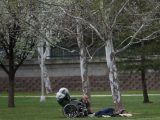My Mercury News Op-Ed on denial over land use and California wildfires (with a mention of climate change)
November 22, 2019
Not really about climate change denial, which is a second-degree problem in California, but the Op-Ed opposes dispersed sprawl development in the countryside. And that has a terrible carbon footprint.
Link here, and the original text below:
Link here, and the original text below:
As still more wildfires hit California this fall, we remain in denial about the primary cause of our disastrous wildfire risks. Climate change contributes to wildfire now and will grow even further in importance, but it is not currently the primary risk factor and not subject to denial here in climate-conscious California. Similarly, there’s no denial of the need for certain helpful actions, using different building materials and setting prescribed fires to burn out fuel loads before they get out of control. These acknowledged issues also are not the primary drivers of wildfire risks, although they dominate the discussion and potential actions by government agencies.
The primary factor creating wildfire risk is land use, specifically the extent to which we scatter residential development in wildland areas, like lighter fluid on a bundle of wood. California county and city governments do not acknowledge this fact in their own “mini-constitutions,” their General Plans. Until they do – and then take action to do something about it – wildfire history will continue to tragically repeat itself.
Research has made clear that the greatest risk of losing a home to fire comes from land use decisions that disperse development across the Wildand-Urban Interface, the so-called “WUI”. You can map this risk rising and falling like a hill on a graph, where risk is low at very low density development in the WUI, rises high in the middle level of density, and then drops low again with increased density approaching suburban lots. Research from Dr. Alexandra Syphard of the Conservation Biology Institute, and by many others, has demonstrated the problem.
In wilder areas with few residences, the chances of a human-caused ignition are low, and the space for a fire to burn out without harming anyone are higher. In places with suburban residential densities or greater density, the amount of trees and brush that catch and carry fire are lower, fire stations are closer and quicker to respond, and multiple homes can be protected at the same time. Between the two with the highest level of risk is the worst of all worlds, where residences are scattered liberally as ignition sources will plenty of wildland fuels to threaten life and property. That worst of all worlds is what land use planning for rural areas usually designates in county General Plans, as well as many cities that also oversee undeveloped lands.
Look at the General Plans for Santa Clara County, Contra Costa County, and Sonoma County, and you will not find an acknowledgment of land use patterns as the primary driver of fire risk. At best they have some suggestion of minimizing development in fire hazard areas, not an acknowledgment that this development is the core problem. These three counties are now revising their General Plans, and now is the time to fix this problem.
Counties and cities need first to get over the denial and to expressly acknowledge that scattering new development in the WUI is currently the primary driver of wildfire risk. Then they start doing something about it. Doing something would not mean forcing people out, but it could put strong restrictions on new development and give alternatives to people after a wildfire who do want to leave.
The good news is that while land use planning doesn’t yet acknowledge the problem, recognition is increasing in the media and in public discussion. We need the land use driver of wildfire risk to be acknowledged where it counts most, in county and city General Plans. Just like climate change, we must acknowledge and end this denial in order to have a chance to overcome it.


